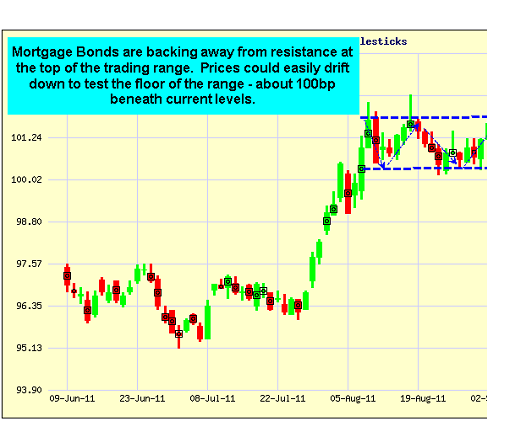Friday’s steep sell off in Bonds is the fifth consecutive session of declines and makes many wonder if the party is over for low mortgage rates.
All the gains made due to Bernanke’s “Significant Downside Risks” and the start of Operation Twist have evaporated. Fortunately, the decline in Bond prices has been halted at the 50-day moving average. A drop below this level of support could result in further losses; hence Bonds could loose as much as 100 basis points from current levels and push Mortgage Rates higher. For now it appears Bonds are back to trading in a sideways pattern as the they did prior to September 21st.
For those new to “Market Update” it’s important to understand how Mortgage Rates move and what effects them. Contrary to popular belief, Mortgage Rates are tied to the Fannie Mae Bond Market (FNMA) Not the 10-Year Bond. So, if the FNMA Bond prices move higher, the yield (interest rate) moves lower. Therefore I monitor economic news that can affect the prices of FNMA Bonds. One of the most significant being inflation. Bond investors fear any news of inflation; it causes investors to sell Bonds, which causes the price of Bonds to drop and the rates to rise.
This weeks Kiplinger Letter reported; The slow economy will keep a damper on demand through 2012, and ample supplies of resources…from workers to raw materials…mean little pressure on wages or prices for at least the next year or so. But come 2013 or soon after: Watch out. Annual inflation of 5%-6% or more is a good bet, even if economic growth remains pokey. If the pace picks up, inflation will climb even higher. Worse, the trend may continue for years.
Adding pressure to Bonds was Friday’s Jobs Report. The Labor Department reported that 103 thousand jobs were created in September, higher than expectations of 60 thousand. However, 45 thousand of those jobs were due to the return of striking Verizon workers.
The FNMA 3.50% Coupon Bond fell 69 basis points to end the week at 101.41, 250 basis points lower than the high of 104.00 reached back on September 22nd.
I am recommending floating/not locking into mortgage rates for those at the beginning of the application stage. If we’ve learned one thing over the past year is that this is a very volatile market. Let the volatility be your friend. However, you will need to work with a Mortgage professional that monitors these markets closely and can react in an instant.


